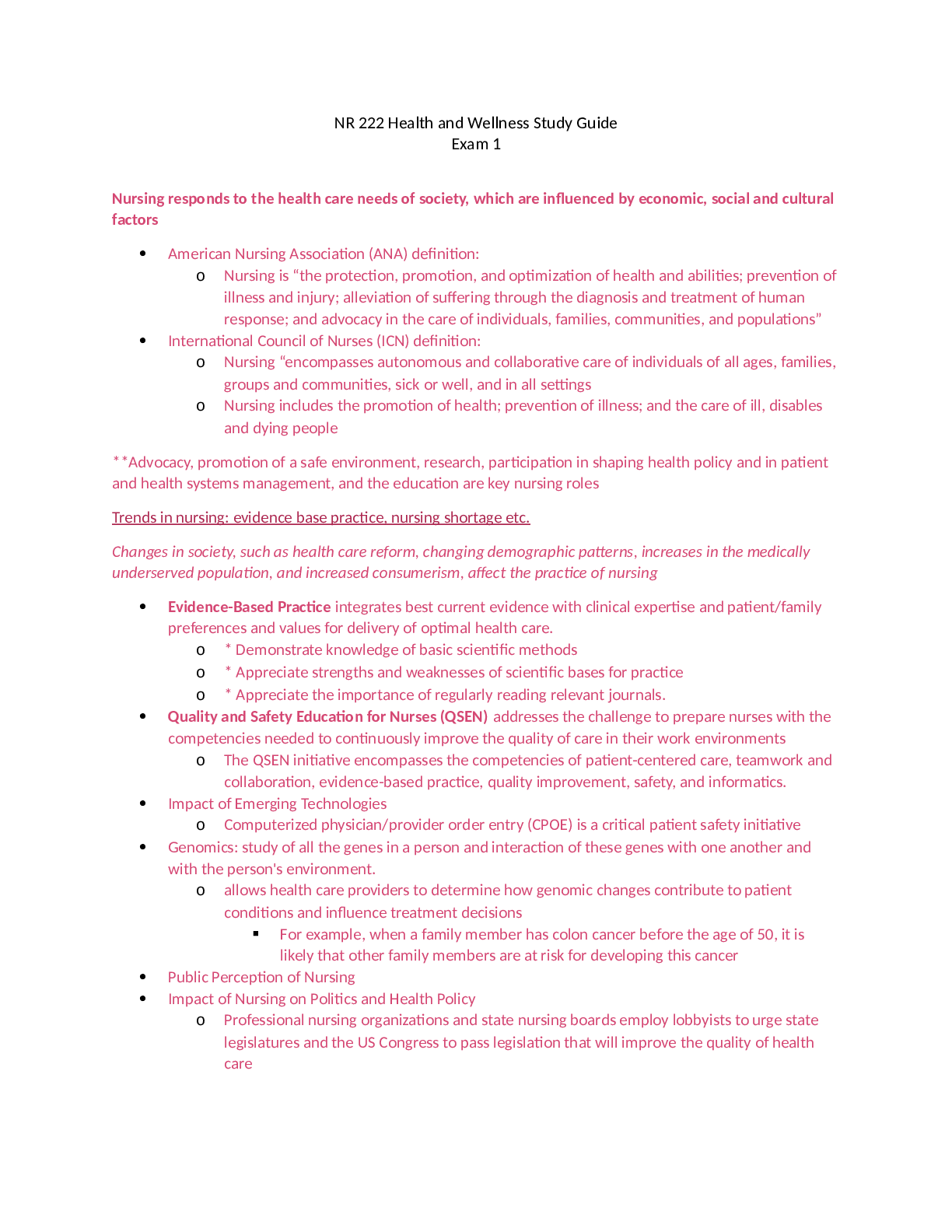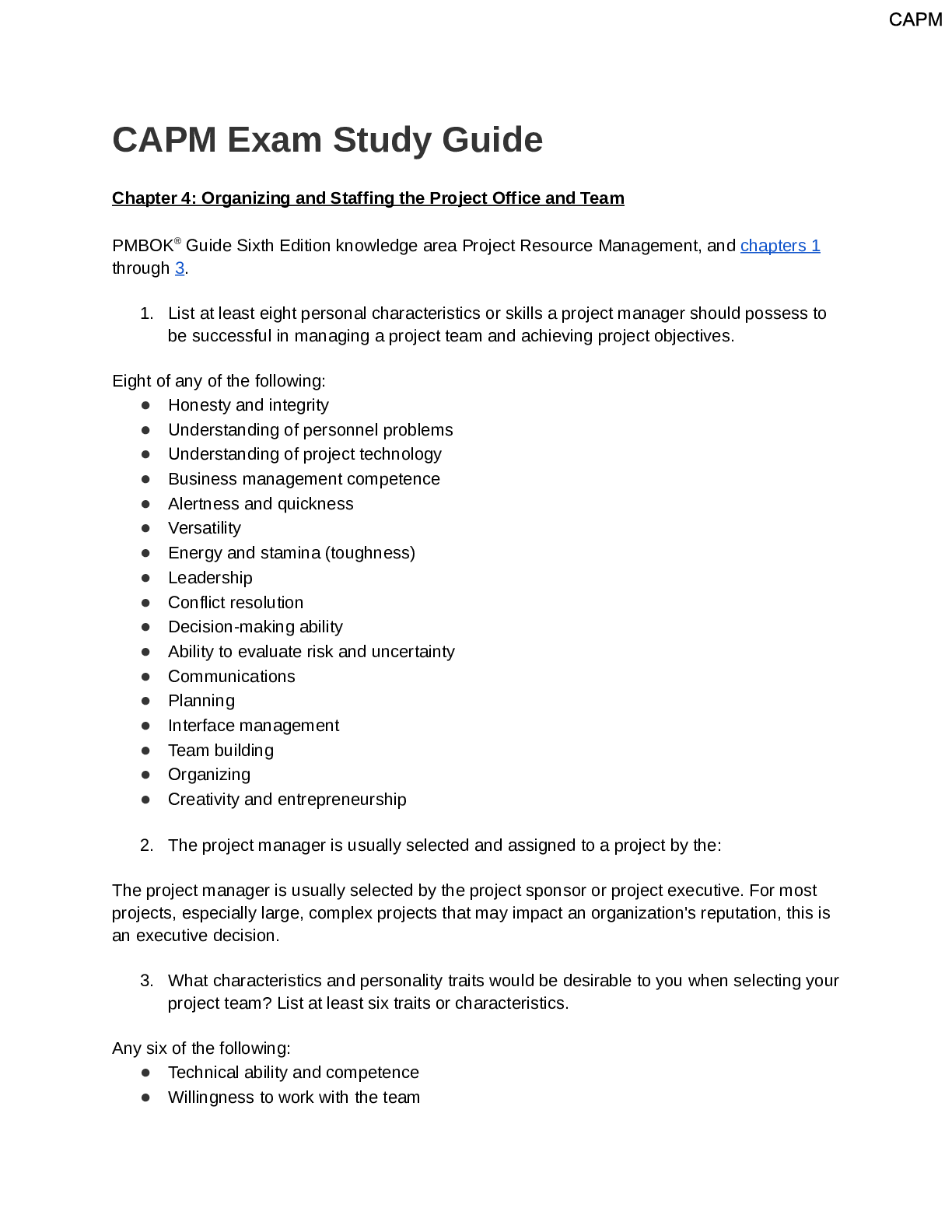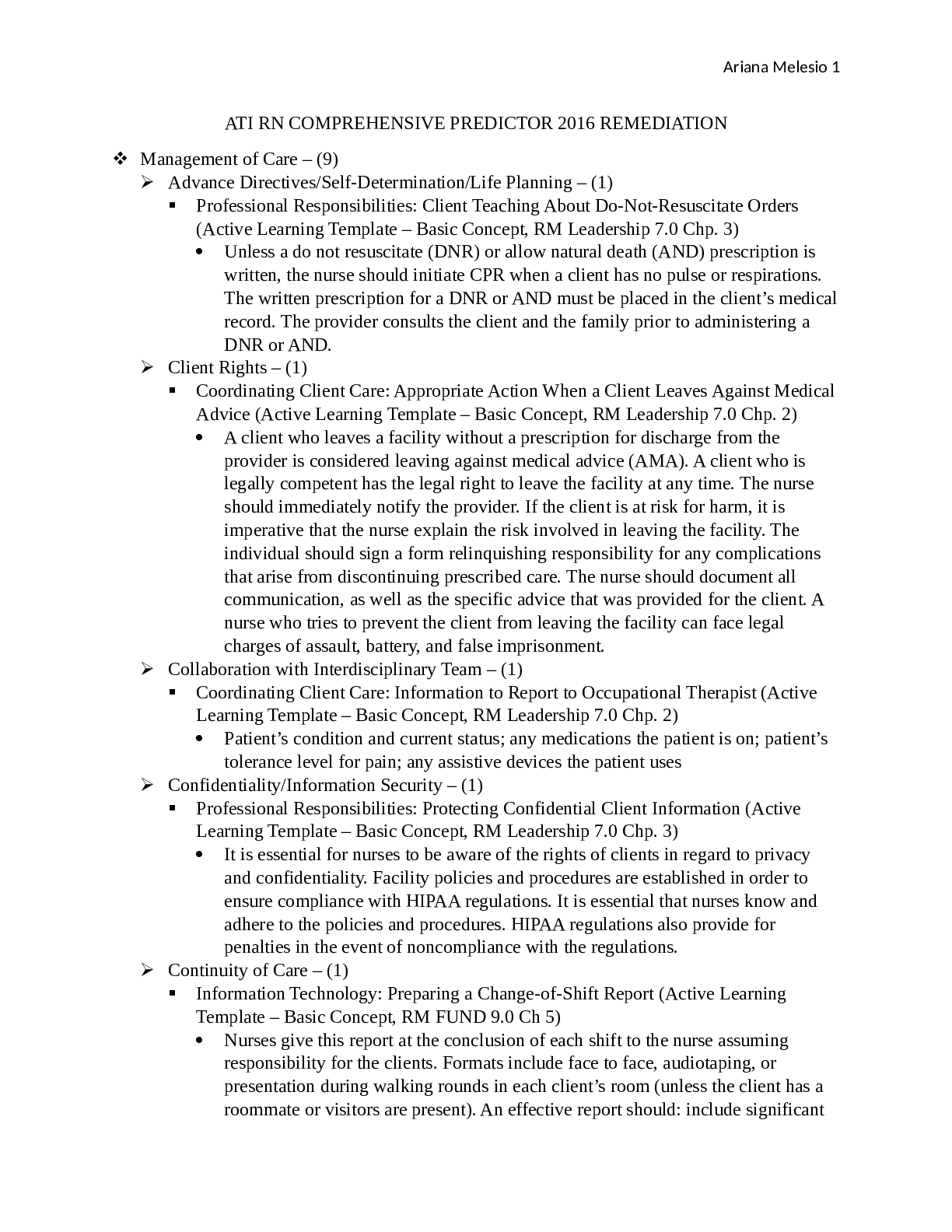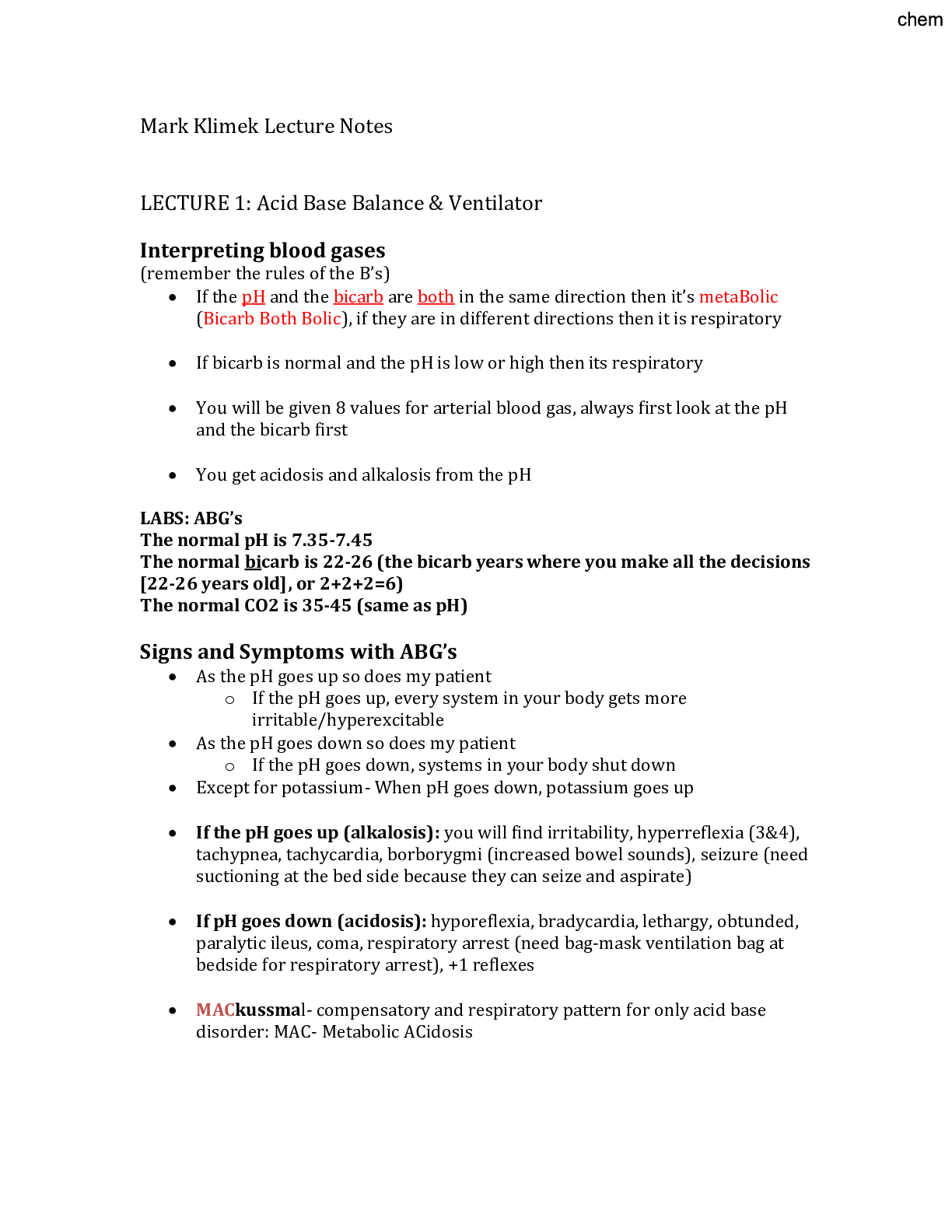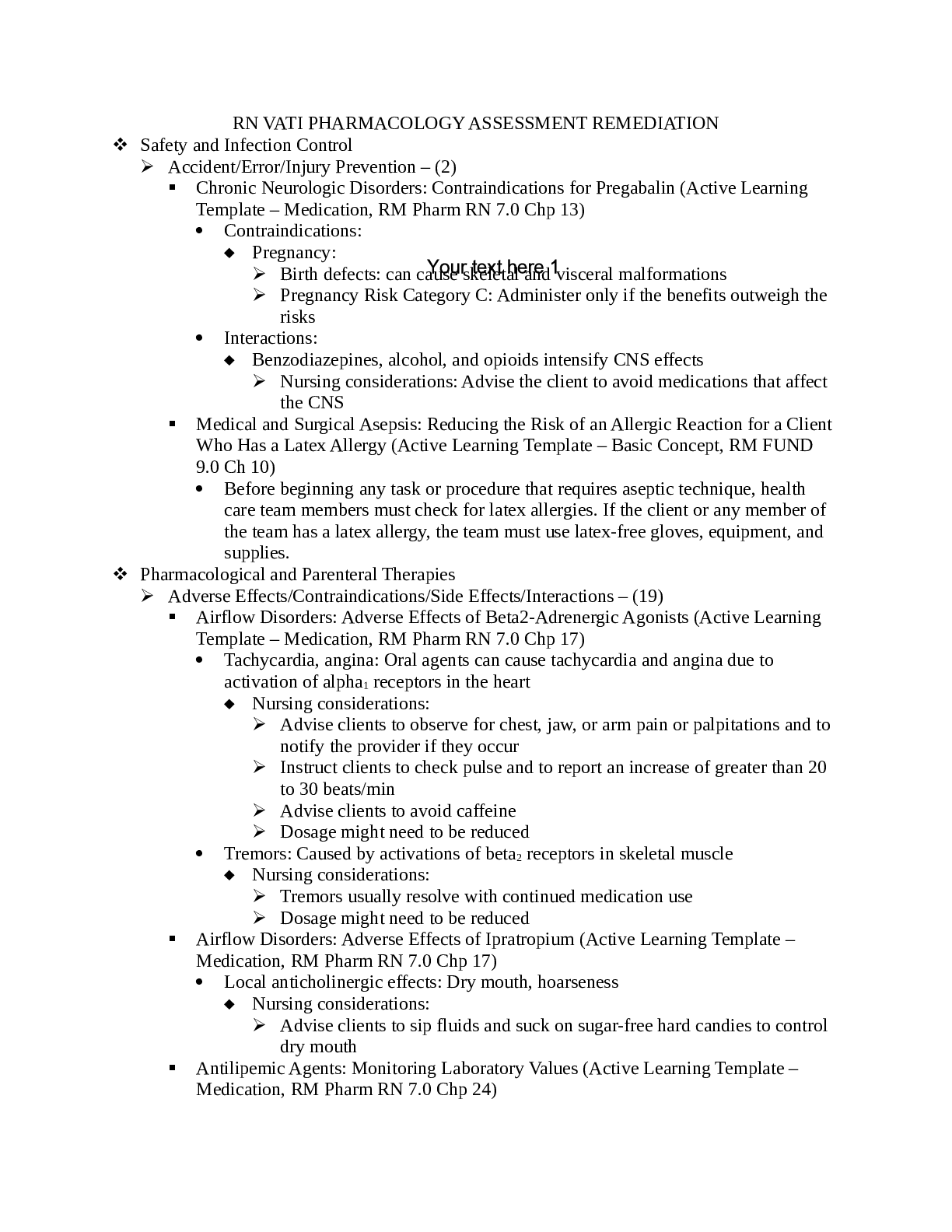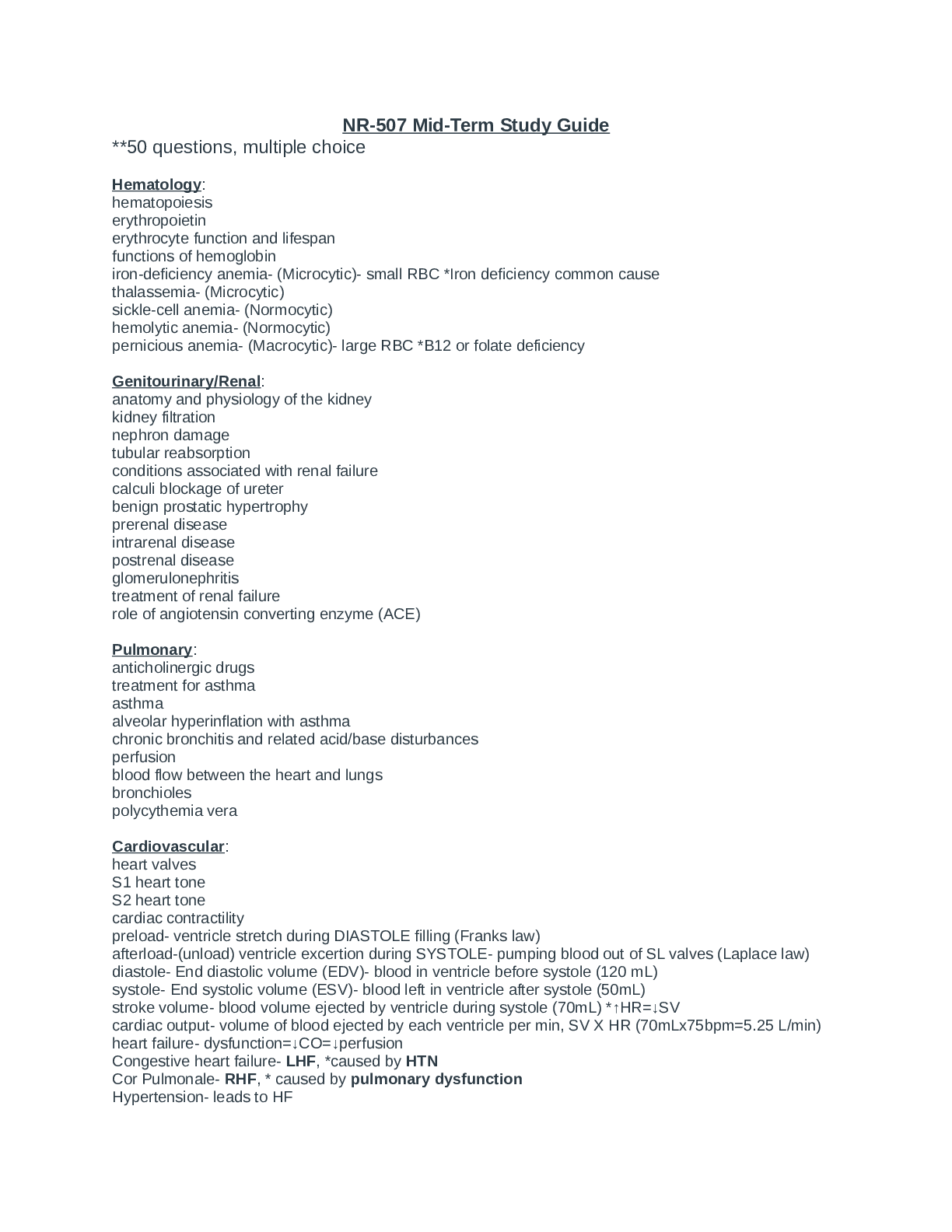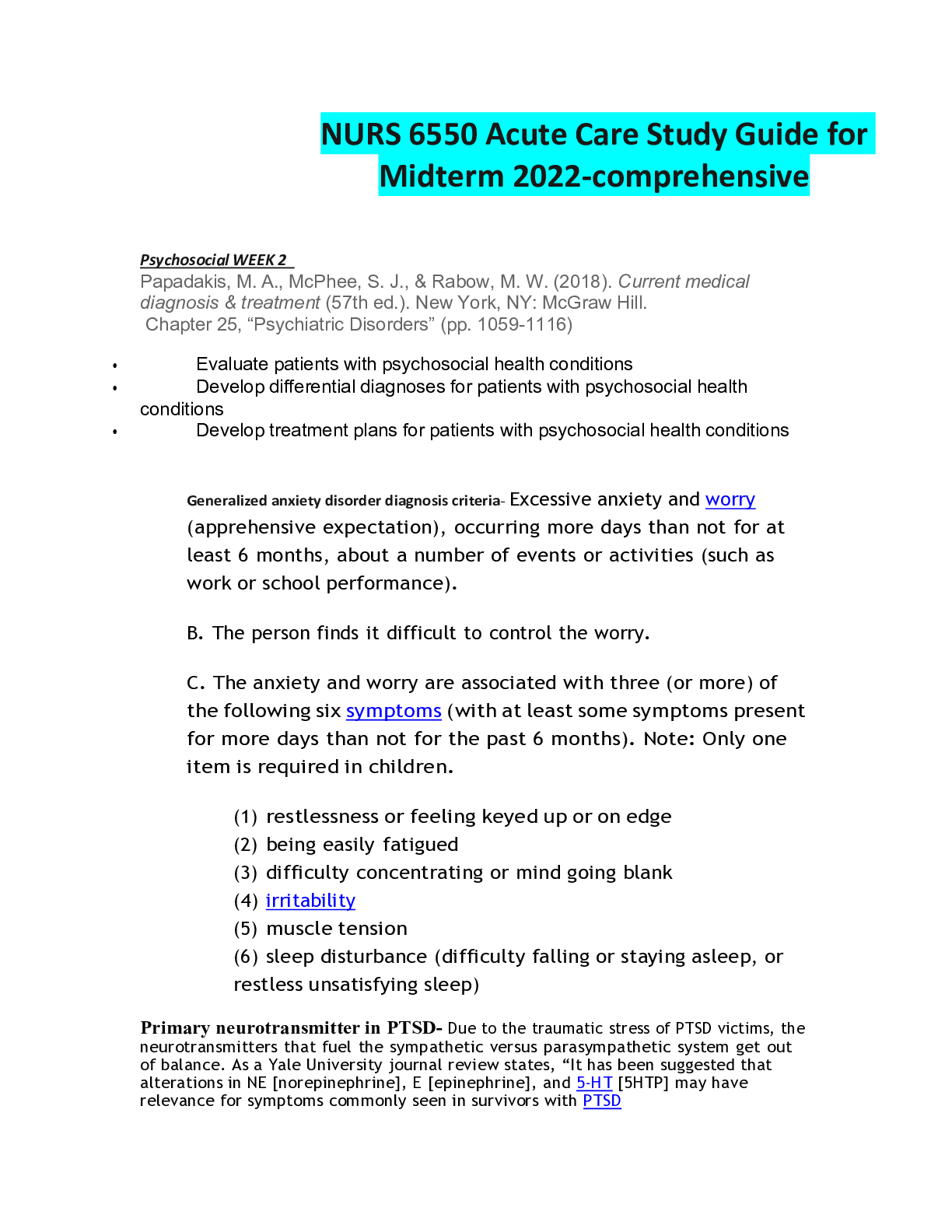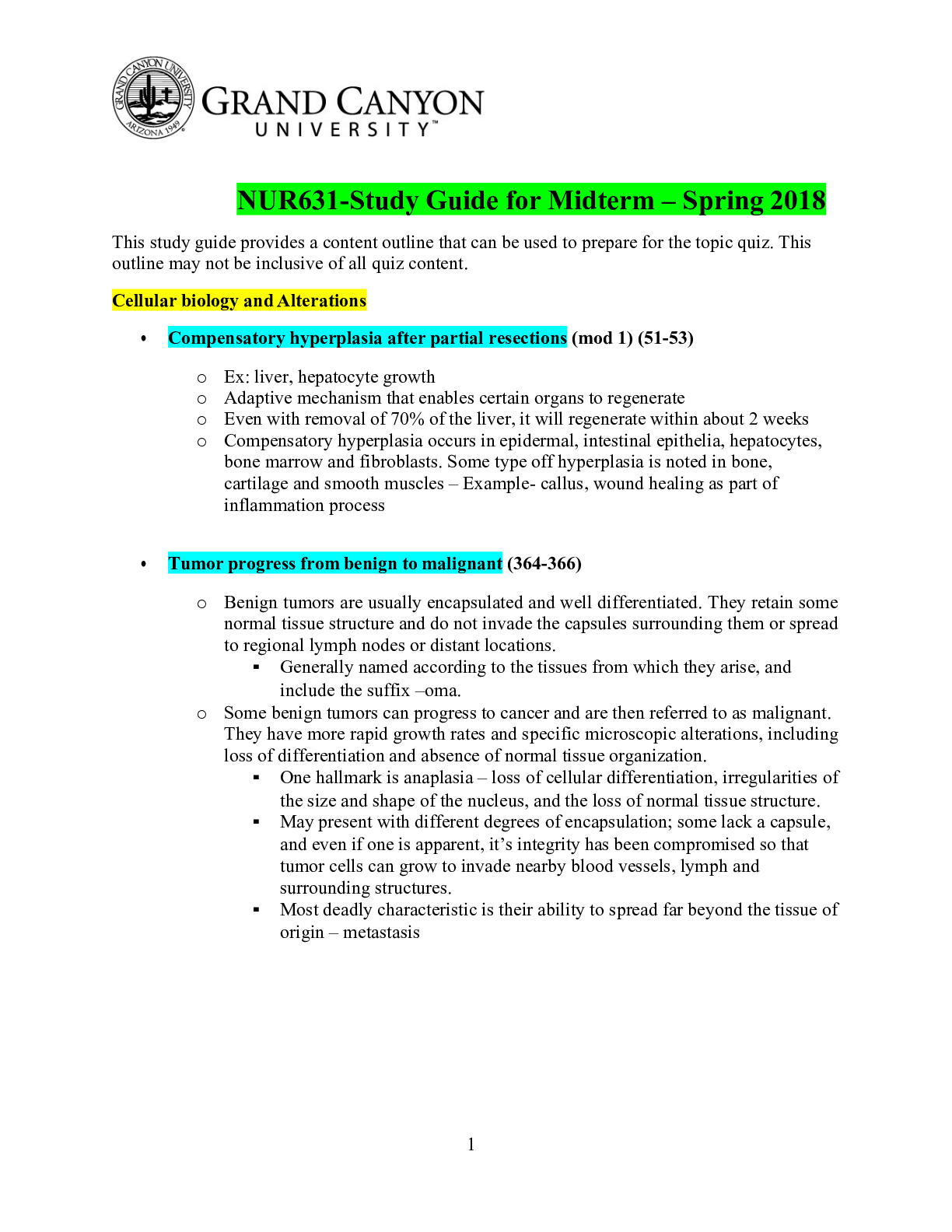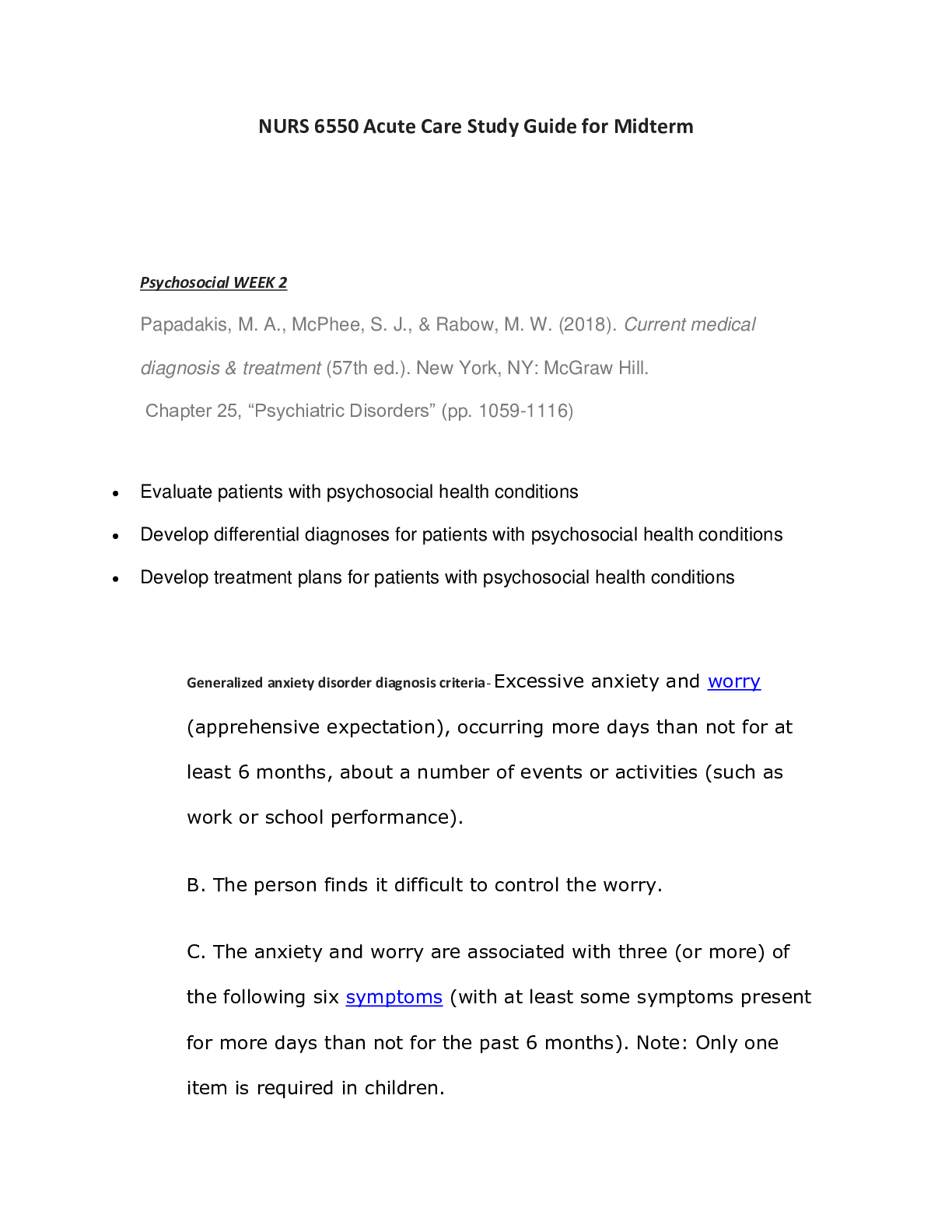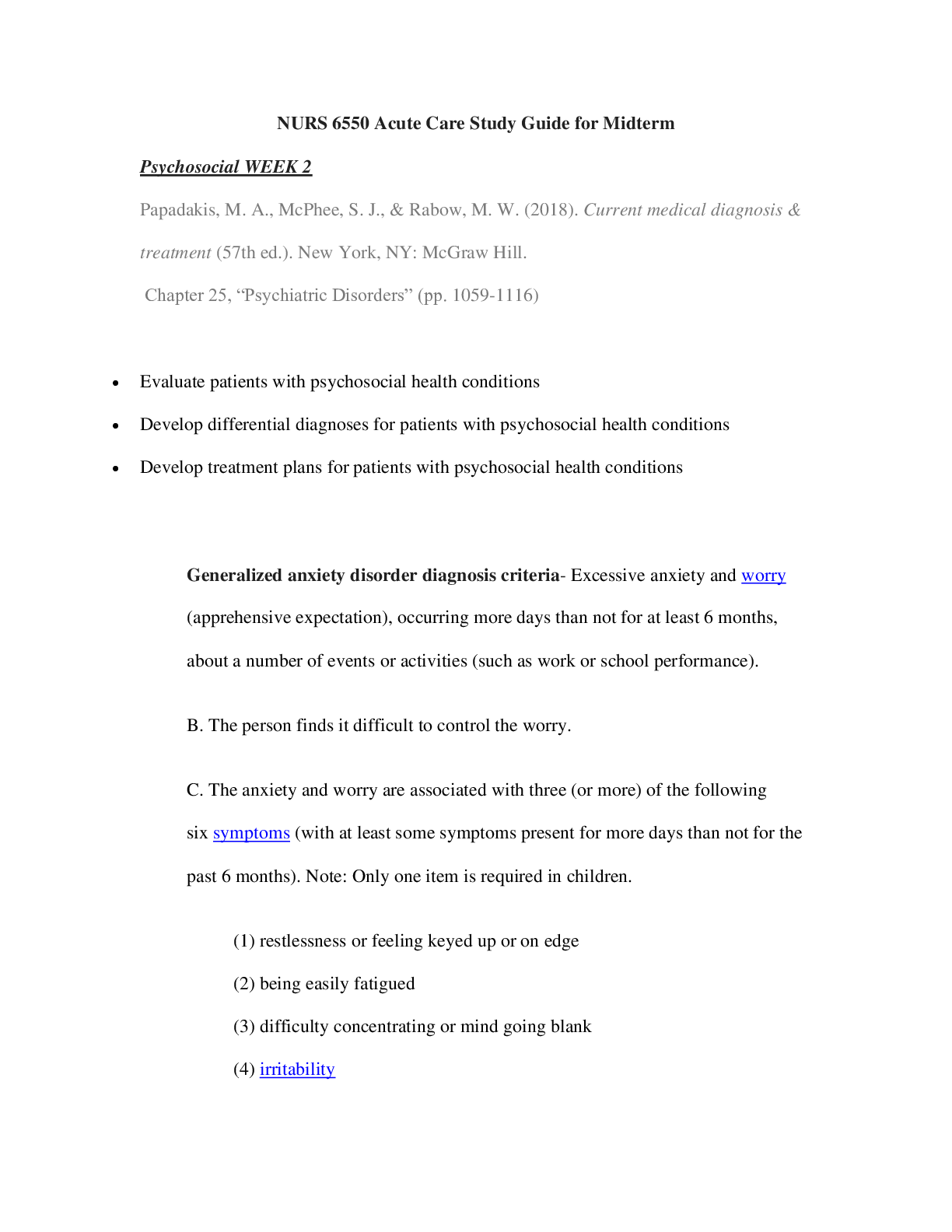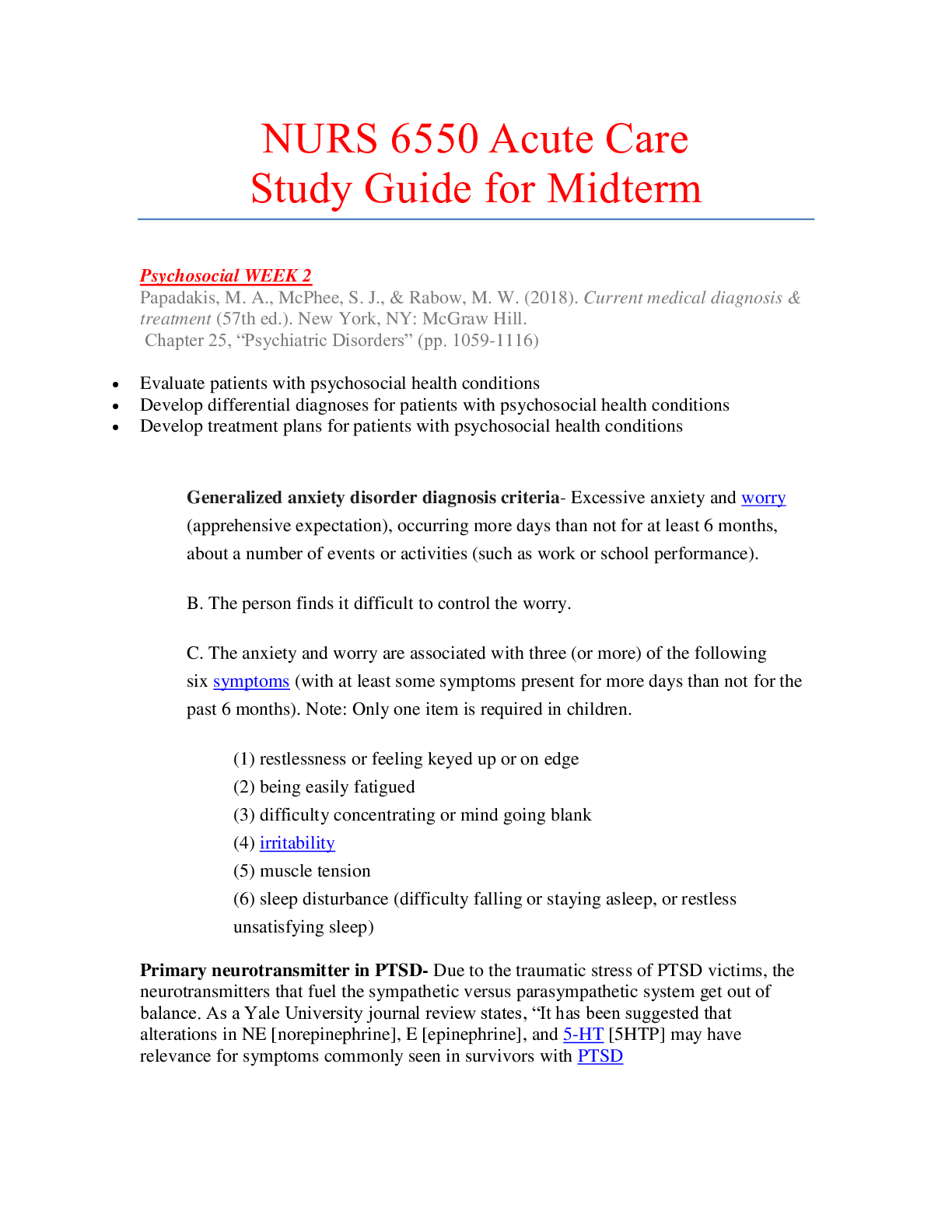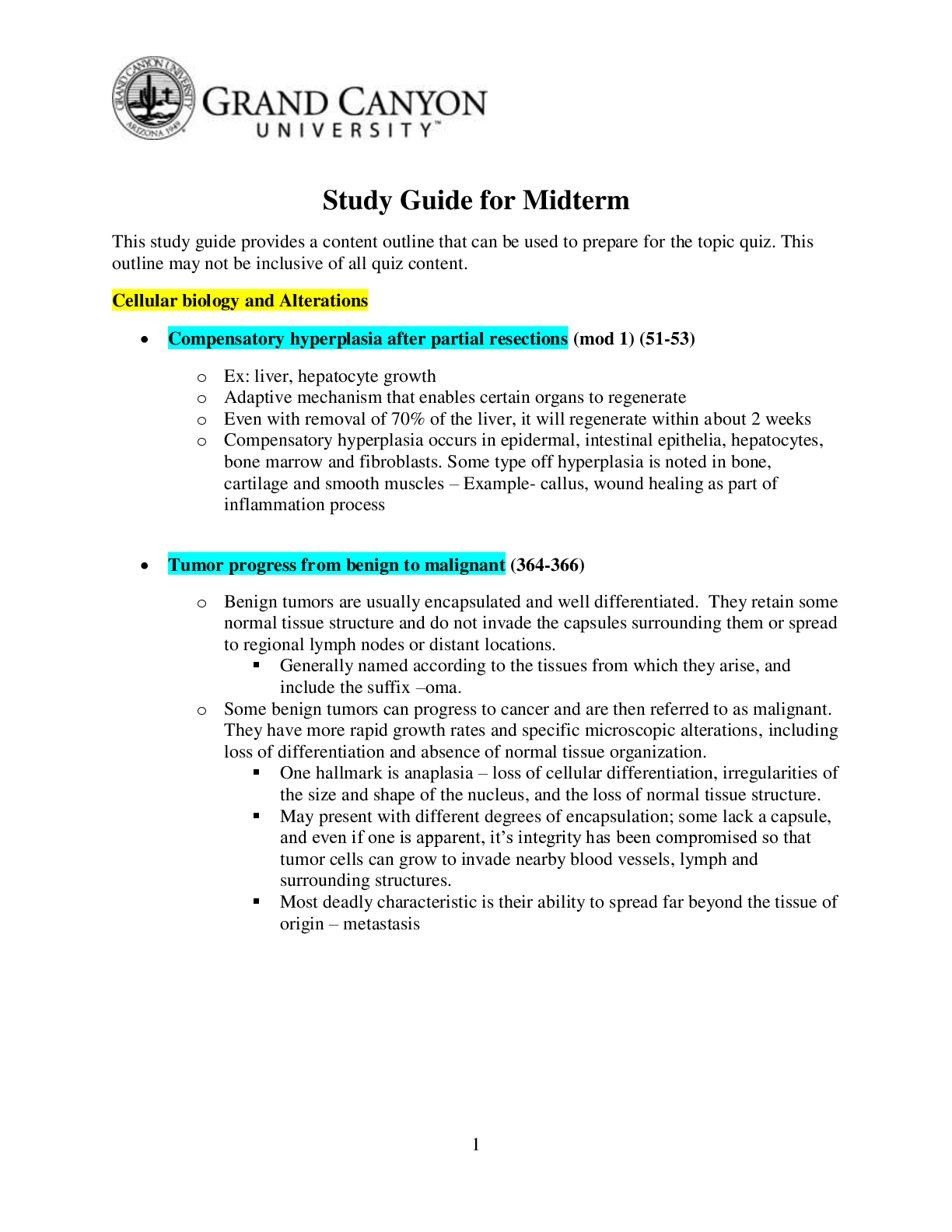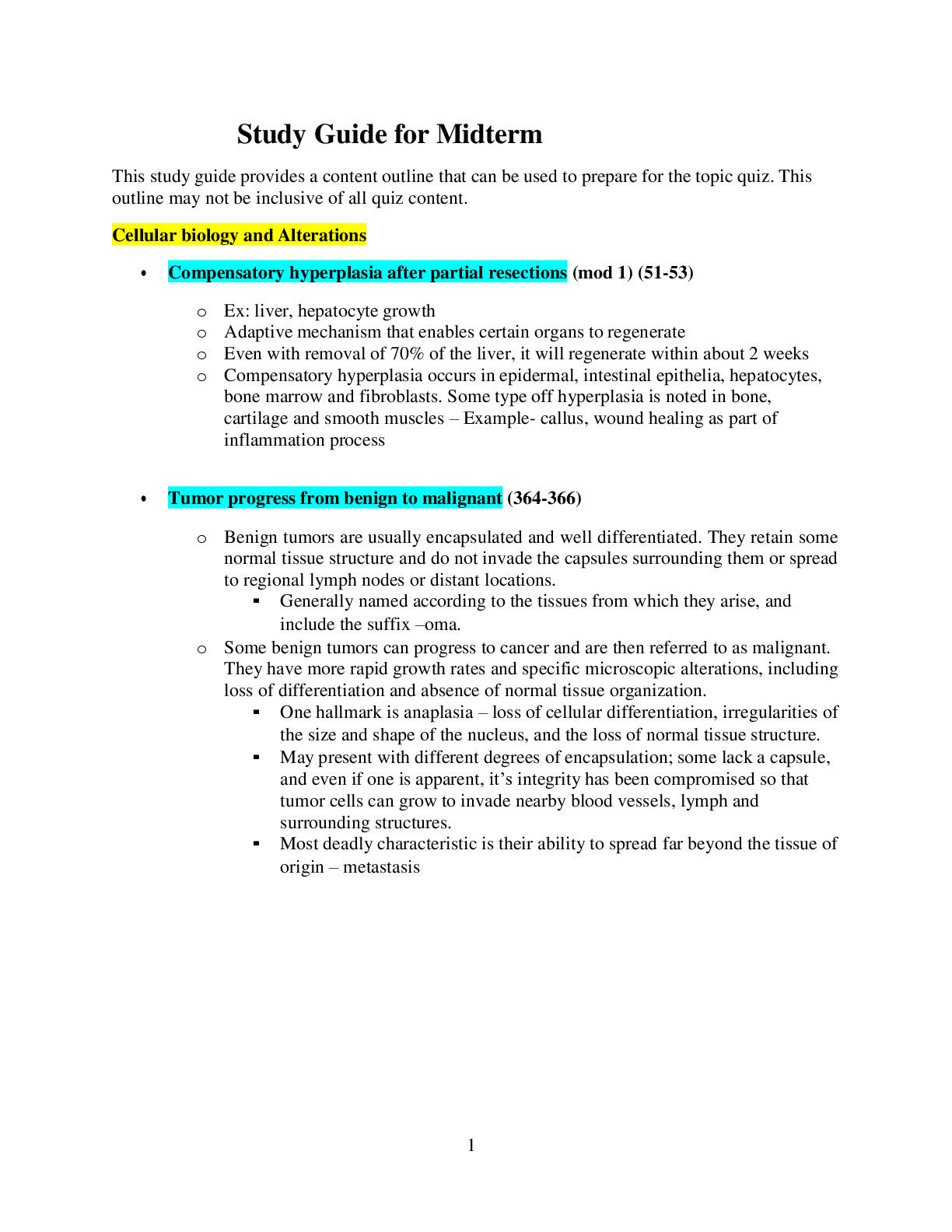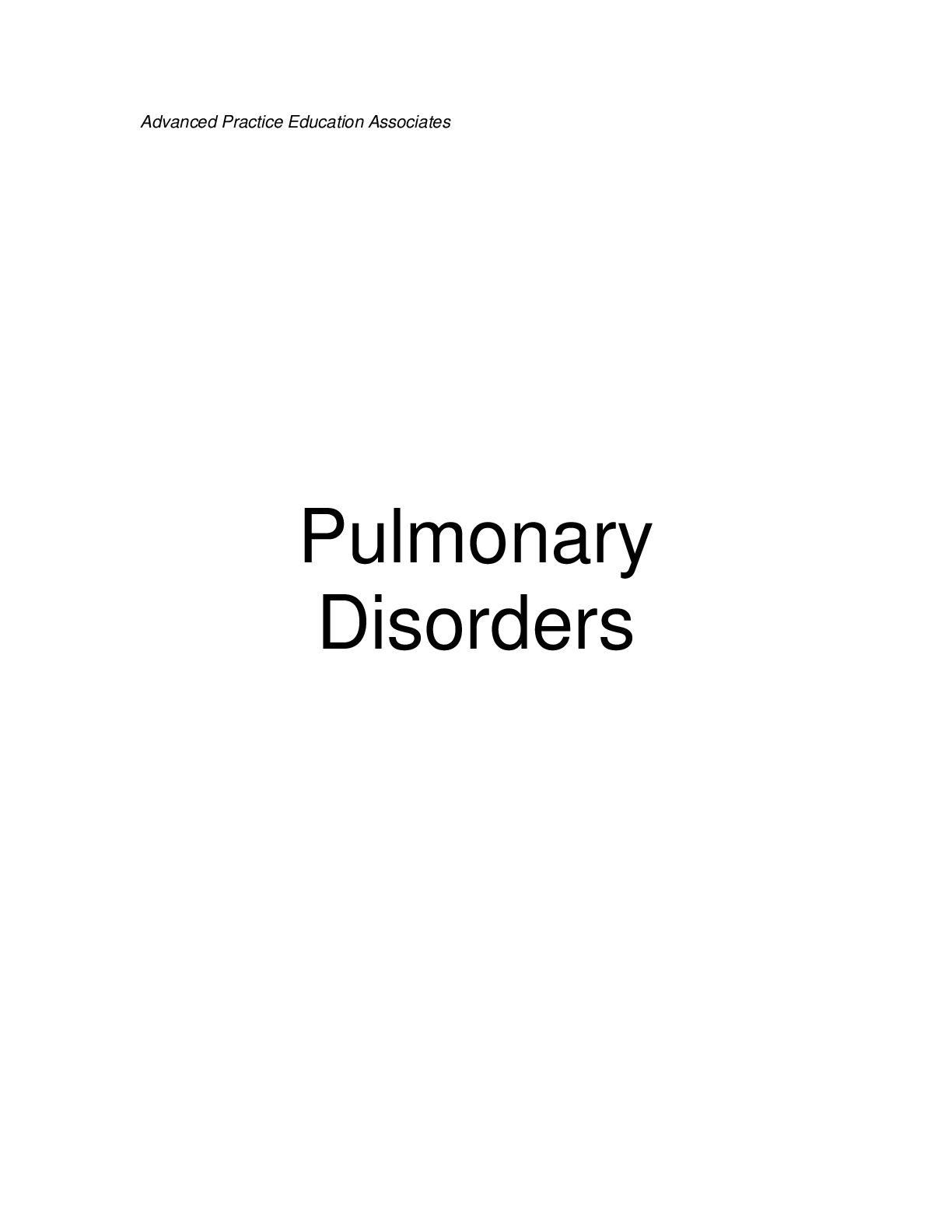Health Care > STUDY GUIDE > NURS 6550 Acute Care Study Guide for Midterm (All)
NURS 6550 Acute Care Study Guide for Midterm
Document Content and Description Below
Evaluate patients with psychosocial health conditions Develop differential diagnoses for patients with psychosocial health conditions Develop treatment plans for patients with psychosocial ... health conditions Generalized anxiety disorder diagnosis criteria- Excessive anxiety and worry (apprehensive expectation), occurring more days than not for at least 6 months, about a number of events or activities (such as work or school performance). B. The person finds it difficult to control the worry. C. The anxiety and worry are associated with three (or more) of the following six symptoms (with at least some symptoms present for more days than not for the past 6 months). Note: Only one item is required in children. (1) restlessness or feeling keyed up or on edge (2) being easily fatigued (3) difficulty concentrating or mind going blank (4) irritability (5) muscle tension (6) sleep disturbance (difficulty falling or staying asleep, or restless unsatisfying sleep) Primary neurotransmitter in PTSD- Due to the traumatic stress of PTSD victims, the neurotransmitters that fuel the sympathetic versus parasympathetic system get out of balance. As a Yale University journal review states, “It has been suggested that alterations in NE [norepinephrine], E [epinephrine], and 5-HT [5HTP] may have relevance for symptoms commonly seen in survivors with PTSD * PTSD diagnosis and treatment-assessing history of exposure to a perceived or actual life threatening event, serious injury or sexual violence, symptoms lasting more than 1 month. Disturbance causes clinically significant distress or impairment in functioning H) The disturbance is not attributable to the physiological effects of a substance or other medical condition DSM-5 recognizes a “with dissociative symptom” specifier when the PTSD symptoms are accompanied by persistent or recurrent depersonalization or derealization. The specifier “with delayed expression” should be included if the full criteria for PTSD are not met for more than 6 months following the trauma. The traumatic event is persistently re-experienced: Nightmares Intrusive thoughts of the traumatic event Flashbacks Marked emotional distress when exposed to traumatic reminders Strong physiologic reaction when exposed to traumatic reminders Treatment psychotherapy (cognitive processing, prolonged exposure therapy, eyemovement desensitizing) . SSRIs (sertraline, paroxetine) clonidine 0.1mg at bed time, prazosin 2-10mg for nightmare, antiseizure meds for anger management (carbamazepine 400-800mg daily), clonazepam 1-4mg daily for anxiety, Trazodone 25-100mg for sleep. Treatment of acute panic attacks- What are the medications for initial/first line therapy- SL 0.5-1 mg alprazolam, clonazepam 0.5-1mg, antidepressants, SSRIs (sertraline 25mg/day for 1 week, then 50mg) Inpatient treatment of depression- ECT o What are the therapies for patient’s that won’t eat, take meds, etc. When is serotonin norepinephrine reuptake inhibitor indicated, when is it contraindicated? For pain neuropathy/fibromyalgia Venlafaxine dosing, when is follow up? What are you monitoring? - Blood pressure monitoring, arrhythmias DOSE is 150-225 mg daily. Patients should be cautioned about the concomitant use of Venlafaxine tabletsand NSAIDs, aspirin, warfarin, or other drugs that affect coagulation since combined use of psychotropic drugs that interfere with serotonin reuptake and these agents has been associated with an increased risk of bleeding (see PRECAUTIONS,Abnormal Bleeding). Usual Adult Dose for Anxiety Extended release: Initial dose: 75 mg orally once a day Maintenance dose: May increase in daily increments of 75 mg orally at intervals of no less than 4 days Maximum dose: 225 mg orally per day Usual Adult Dose for Panic Disorder Extended release: Initial dose: 37.5 mg orally once a day Maintenance dose: May increase dose in daily increments of 75 mg orally at intervals of no less than 7 days Maximum dose: 225 mg orally per day Usual Adult Dose for Depression Immediate release: Initial dose: 37.5 mg orally twice a day or 25 mg orally 3 times a day Maintenance dose: May increase in daily increments of up to 75 mg orally at intervals of no less than 4 days Maximum dose: (moderately depressed outpatients): 225 mg orally per day Maximum dose (severely depressed inpatients): 375 mg orally per day Comments: -Daily dosage may be divided in 2 or 3 doses/day Endogenous depression pathophysiology is best described as? Endogenous depression. Endogenous depression (melancholia) is an atypical sub-class of the mood disorder, major depressive disorder (clinical depression). Endogenous depression occurs due to the presence of an internal (cognitive, biological) stressor instead of an external (social, environmental) stressor. No apparent outside cause. Exogenous is caused by something (stress, some event) Differences between panic attacks and panic disorder? Panic attacks are recurrent, unpredicted episodes of intense surges of anxiety accompanied by marked physical manifestations. Panic Disorder Someone with generalized anxiety disorder (GAD) has chronic anxiety, and a tendency to become overanxious about issues which would not normally cause concern. Panic disorder is characterized by repeated episodes of panic attacks, in which the individual is overcome by feelings of fear and dread. What are Major Depressive disorder symptoms?- physical & cognitive symptoms, loss of interest and pleasure(anhedonia) withdrawal from activities and guilt, poor concentration, worthlessness, fatigue Identify the primary neurotransmitter in PTSD PTSD diagnosis and treatment, meds (families/common meds)? Familiarize yourself with the side effects of Lithium- GI, tremors-treat with propranolol 20- 60mg a day, weakness, somnolence, polyuria (reduced renal response ADH) , polydipsia (increased plasma renin concentration), thyroid, EKG changes, long term effects cogwheel rigidity, affect Common adverse effects of atypical antipsychotics- anticholinergic side effects dry mouth which can cause increases caloric liquid intake (wt gain & hyponatremia) blurred vision, urinary retention, delayed gastric emptying, esophageal reflux, ileus, delirium, acute glaucoma, sexual disturbances, and orthostatic hypotension, EKG changes prolonged QT Mental status changes in elderly… how do you evaluate? Mental status changes related to UTI in elderly Assessment of Delirium in geriatric patients- Acute onset, fluctuating course, deficits in attention not memory. Elders with dementia and driving – there is no gold standard assessment, consider the severity of the dementia ( severe should not drive), consider comorbidities and medications, ability to do IADLS, , may need to be assessed by a driver rehab specialist. Short Confusion Assessment Method (Short CAM): what things are assessed? Acute onset and fluctuating course, inattention and either disorganized thinking or ALOC. Types of dementia, know differences? Alzheimer's disease- Alzheimer's disease Most common type of dementia; accounts for an estimated 60 to 80 percent of cases. Symptoms: Difficulty remembering recent conversations, names or events is often an early clinical symptom; apathy and depression are also often early symptoms. Later symptoms include impaired communication, poor judgment, disorientation, confusion, behavior changes and difficulty speaking, swallowing and walking. Revised guidelines for diagnosing Alzheimer’s were published in 2011 recommending that Alzheimer’s be considered a slowly progressive brain disease that begins well before symptoms emerge. Brain changes: Hallmark abnormalities are deposits of the protein fragment beta-amyloid (plaques) and twisted strands of the protein tau (tangles) as well as evidence of nerve cell damage and death in the brain Vascular dementia- Vascular dementia Previously known as multi-infarct or post-stroke dementia, vascular dementia is less common as a sole cause of dementia than Alzheimer’s, accounting for about 10 percent of dementia cases. Symptoms: Impaired judgment or ability to make decisions, plan or organize is more likely to be the initial symptom, as opposed to the memory loss often associated with the initial symptoms of Alzheimer's. Occurs from blood vessel blockage or damage leading to infarcts (strokes) or bleeding in the brain. The location, number and size of the brain injury determines how the individual's thinking and physical functioning are affected. Brain changes: Brain imaging can often detect blood vessel problems implicated in vascular dementia. In the past, evidence for vascular dementia was used to exclude a diagnosis of Alzheimer's disease (and vice versa). That practice is no longer considered consistent with pathologic evidence, which shows that the brain changes of several types of dementia can be present simultaneously. When any two or more types of dementia are present at the same time, the individual is considered to have mixed dementia Dementia with Lewy bodies (DLB)- Dementia with Lewy bodies (DLB) back to top Symptoms: People with dementia with Lewy bodies often have memory loss and thinking problems common in Alzheimer's, but are more likely than people with Alzheimer's to have initial or early symptoms such as sleep disturbances, well-formed visual hallucinations, and slowness, gait imbalance or other parkinsonian movement features. Brain changes: Lewy bodies are abnormal aggregations (or clumps) of the protein alpha-synuclein. When they develop in a part of the brain called the cortex, dementia can result. Alpha-synuclein also aggregates in the brains of people with Parkinson's disease, but the aggregates may appear in a pattern that is different from dementia with Lewy bodies. The brain changes of dementia with Lewy bodies alone can cause dementia, or they can be present at the same time as the brain changes of Alzheimer's disease and/or vascular dementia, with each abnormality contributing to the development of dementia. When this happens, the individual is said to have mixed dementia. Mixed dementia- Mixed dementia In mixed dementia abnormalities linked to more than one cause of dementia occur simultaneously in the brain. Recent studies suggest that mixed dementia is more common than previously thought. Brain changes: Characterized by the hallmark abnormalities of more than one cause of dementia — most commonly, Alzheimer's and vascular dementia, but also other types, such as dementia with Lewy bodies. Parkinson's disease- Parkinson's disease As Parkinson's disease progresses, it often results in a progressive dementia similar to dementia with Lewy bodies or Alzheimer's. Symptoms: Problems with movement are common symptoms of the disease. If dementia develops, symptoms are often similar to dementia with Lewy bodies. Brain changes: Alpha-synuclein clumps are likely to begin in an area deep in the brain called the substantia nigra. These clumps are thought to cause degeneration of the nerve cells that produce dopamine. [Show More]
Last updated: 1 year ago
Preview 1 out of 45 pages

Reviews( 0 )
Document information
Connected school, study & course
About the document
Uploaded On
Jun 26, 2022
Number of pages
45
Written in
Additional information
This document has been written for:
Uploaded
Jun 26, 2022
Downloads
0
Views
30


